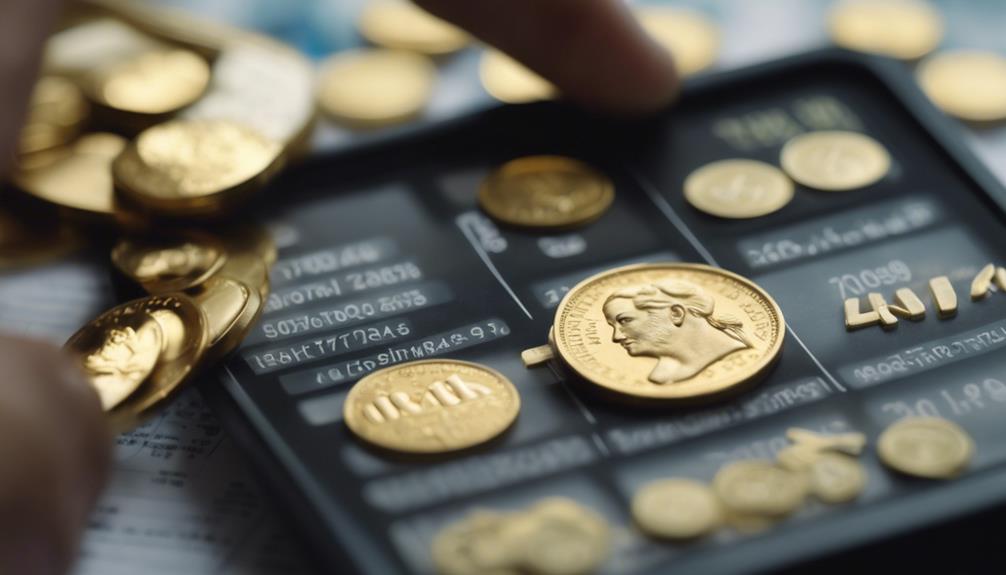Diversifying our retirement portfolio with gold through a 401K has advantages such as protection against inflation, stability in uncertain markets, and tax benefits with a Gold IRA. Taking advantage of gold’s low correlation with traditional assets is key. The process, which involves direct or indirect rollovers, requires consideration of tax implications such as a 20% withholding for indirect transfers. Opting for physical gold bars or coins provides direct ownership benefits. Investing in gold mutual funds or ETFs helps diversify holdings and reduce risk. It is crucial to understand the 28% tax rate on gold profits. Delve further into ways to maximize long-term growth while minimizing tax liabilities.
Key Takeaways
- Consider a Gold IRA rollover for tax advantages and diversification.
- Choose between physical gold or gold ETFs for 401K diversification.
- Consult a financial advisor for personalized advice on gold investments.
- Understand tax implications on gold purchases within a 401K.
- Diversify 401K with gold to hedge against market uncertainties.
Advantages of Investing in Gold

Investing in gold offers a range of advantages, making it a valuable addition to a diversified retirement portfolio. Gold serves as a hedge against inflation, safeguarding your wealth from the erosive effects of rising prices and currency devaluation.
By incorporating gold into your investment mix, you enhance diversification due to its low correlation with traditional assets like stocks and bonds. Despite not yielding dividends or interest, gold's inherent value acts as a stable store of wealth, especially during market uncertainties and economic downturns.
When considering financial goals and investment decisions, the inclusion of gold can provide an important buffer against volatility. Additionally, for those looking to secure their retirement savings, leveraging an IRA gold or precious metals IRA can offer tax advantages while bolstering your portfolio with the unique benefits that gold provides.
It's crucial to weigh the costs associated with storing physical gold against the potential advantages it brings to your long-term financial strategy.
Gold IRA Rollover Process

To kickstart the Gold IRA rollover process, one must first decide between a direct or indirect rollover method. A direct rollover involves transferring funds from a traditional retirement account into a self-directed IRA that includes gold investments, with the money moving directly from one custodian to another.
On the other hand, an indirect rollover requires you to receive the funds and redeposit them into the new account within 60 days. Please note that indirect rollovers might have a 20% withholding for taxes, which you'll need to replenish with personal funds to avoid penalties.
Additionally, transferring funds from a pre-tax account to a Roth IRA as part of a rollover incurs tax liabilities. During the rollover process for a Gold IRA, you'll need to choose a custodian to manage the gold assets and decide whether to invest in physical gold bullion or gold coins for the account.
Types of Gold Investments

After understanding the Gold IRA rollover process, exploring the various types of gold investments available within a 401(k) becomes an essential step towards diversifying one's retirement portfolio. Gold mutual funds are one option, offering exposure to gold through investments in gold mining companies. These funds are commonly included in retirement portfolios due to their potential to hedge against market volatility.
Gold ETFs provide a cost-effective way to invest in gold without the need for physical possession of the metal, offering investors a convenient and liquid option. Physical gold IRAs, on the other hand, allow for direct ownership of gold bars or coins within a retirement account, providing tangible benefits such as diversification and a hedge against inflation.
Gold mining stocks are another alternative within a 401(k), offering exposure to the gold mining industry's potential returns. Understanding these investment options is essential for building a well-rounded retirement portfolio that can withstand market fluctuations.
Tax Implications and Considerations

Exploring the tax implications and considerations of gold investments in a 401(k) requires careful planning and awareness of potential financial impacts. When investing in gold through a 401(k) or considering a rollover to a Gold IRA, understanding the tax implications involved is key. Profits from gold investments in a 401(k) are typically taxable at a 28% rate, which can have a substantial impact on your overall returns. Additionally, a direct rollover of funds within 60 days can help you avoid penalties and taxes. However, transferring funds to a Roth IRA may entail paying taxes, so it's important to weigh the pros and cons carefully.
To navigate these complexities, consulting a financial advisor is advisable. These professionals can provide personalized tax advice tailored to your specific retirement investment goals and circumstances. By seeking expert guidance, you can make informed decisions about diversifying your portfolio with gold while minimizing tax obligations and maximizing your long-term financial growth.
| Tax Implications and Considerations |
|---|
| Profit Tax Rate: 28% |
| Rollover to Gold IRA: Potential Tax Implications |
| Direct Rollover: Avoid Penalties and Taxes |
| Roth IRA Transfer: Tax Payment Required |
| Financial Advisor: Consult for Personalized Advice |
Tips for Diversifying With Gold

Diversifying with gold involves strategically allocating assets to mitigate risks and enhance portfolio stability. When considering gold investments within your retirement savings account, it's important to assess the various forms of gold available. Physical gold bars are one option, but storing them can incur costs. Another avenue is a self-directed gold IRA, which allows for more flexibility in investment choices. By adding gold to your portfolio, you can diversify your retirement holdings and potentially reduce overall risk.
While gold doesn't provide dividends or interest, its value can fluctuate independently from traditional assets, offering a hedge against inflation and currency fluctuations. It's vital to understand the potential tax implications of holding gold within your retirement accounts. Although gold returns may not always match those of other investments, its stability during market volatility can be a valuable asset in your overall investment strategy. Consider these tips when looking to incorporate gold as an investment to enhance and fortify your retirement portfolio.
Frequently Asked Questions
Can I Use My 401K to Invest in Gold?
Yes, you can invest in gold using your 401(k) by choosing options like gold mutual funds, ETFs, or a Gold IRA rollover. Directly owning physical gold is generally not allowed in most 401(k) plans.
Gold investments within a 401(k) must meet specific criteria, such as fineness requirements and being held by an approved administrator. It's important to understand the rules and available investment vehicles when considering gold in your retirement portfolio.
Should I Roll My 401K Into a Gold Ira?
We suggest considering rolling your 401(k) into a Gold IRA for potential portfolio diversification. This move offers the opportunity to own physical gold assets, providing a hedge against market volatility.
However, it's essential to understand the process's intricacies, including setting up a self-directed IRA and potential tax implications.
Make informed decisions by weighing the benefits and drawbacks to guarantee a secure retirement strategy.
What Is the Best Way to Invest in Gold for Retirement?
When considering gold investments for retirement, gold mutual funds or ETFs within your 401(k) offer exposure to the gold market. Funds like Fidelity Select Gold Portfolio (FSAGX) and ETFs such as iShares Gold ETF (CSGOLD) provide convenient ways to invest in gold.
Evaluate performance, expense ratios, and investment objectives of available options for best diversification. Actively managed mutual funds or passively tracked ETFs suit different strategies and goals. Make informed decisions based on your preferences and objectives.
What Is a Good 401K Portfolio Mix?
A good 401(k) portfolio mix typically consists of a blend of stocks, bonds, and other investments tailored to individual risk tolerance and retirement objectives. Diversification within a 401(k) is essential for risk management and long-term growth potential.
Age influences the ideal mix, with younger individuals often favoring more stocks for growth.
Regularly rebalancing is vital to align allocations with changing financial goals and market conditions for peak performance.
Can Gold be a Safe Investment for Diversifying My Retirement Portfolio?
When it comes to diversifying your retirement portfolio, investing 401k in gold can be a safe option. Gold has historically been a stable investment during economic uncertainties, providing a hedge against inflation and currency fluctuations. Adding gold to your portfolio can help mitigate risk and provide long-term stability.
Conclusion
To sum up, diversifying your retirement portfolio by purchasing gold with your 401k can provide a hedge against market volatility and economic uncertainty.
While some may argue that gold doesn't generate income like stocks or bonds, its stability and value preservation during turbulent times make it a valuable addition to a well-rounded investment strategy.
Consider the benefits of including gold in your retirement savings to guarantee a secure financial future.











